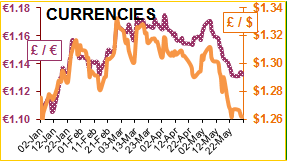The UK wheat market has risen steeply over the last couple of weeks, as the key words for the current picture `remain volatile’ and `uncertainty’ at a period so near to the change between old and new crop. After hitting lows of £141/T in the middle of May the market is currently trading at £155/T. This has been triggered by continued wet weather in the US Midwest. Although this news was not new to the market, after weeks of repeating ‘less than beneficial weather’ the market took notice. As the trade reacted and news extended to warn not only losses in the maize crops but soya also, the `go to if you are an arable farmer and need an alternative to grow is maize in the US. As the high was reached, it triggered technical selling and profit taking as the longer term weather forecast looked more favourable to crop development. Add in uncertainty from our local UK political uncertainty with PM Theresa May announcing her resignation as Tory leader on June 7th and leave as prime Minister when a successor is in place. This left an even greater level of uncertainty over the Brexit deal and caused a steep weakening of the pound sterling against both the Euro and dollar.
The weather in the Midwest of the US has been the wettest 12 month period on record. With recent weeks being particularly wet progress in the planting of maize has been very slow. As concern and prices rose, it is expected that many farmers will attempt to plant in early June to benefit but this and the terrible ground conditions is likely to have negative impacts on yields and quality. Therefore, the global grain markets followed US maize upward. The Trump administration also announced that they would approve an expansion in the use of ethanol fuel as a move to provide a home for US maize and help farmers affected by the lack of export business with China due to the lengthy trade disputes throughout the current season. Despite this impact on the market indications are still positive for the wheat crops in Russia, Europe and indeed mostly for the UK after the recent mix of rain fall and sun. Some small concerns for areas of dryness in the UK and areas of Russia still linger but a good size crop is still expected. It is expected that once harvest commences in these areas, if signs remain positive on yield and quality, then more regional markets may look `inwards’ and cut the string from the currently inflated US price.
Soya markets reacted with the grains moving upward on the continued wet US weather. It is expected that the next USDA figures will have a disappointing story to tell on crop progress that will support prices in the near term, despite expectations that the weather is improving over the coming weeks. The US soya bean carry will be high this season after the extended loss of trade with China and both Brazil and Argentina are planning bigger crops to fuel their new blossoming trading relationships with China so Soya supply should able to cover these US crop losses in Soya beans this season. However, after tight supply in the last few years and with Brazil and Argentina eating into their reserves this season, to service the Chinese demand, there is reason to show a good crop is still required to help replenish stocks that will at some point become short. Adding to the US focus, President Trump continues to fuel trade disruption with a new 5% tariff, this time against Mexico on Exports to combat illegal immigration expected to start on the 10th June. This weighed on demand and added to fear of further tariffs in retaliation from Mexico who are a major buyer of both maize and wheat from the US. This saw the week end with prices pulling back from the highs. African swine fever also continues to draw attention and confusion in already volatile agricultural commodity markets as North Korea confirmed an outbreak near its border with China and South Korea indicated it was increasing biosecurity measures in an attempt to prevent the spread of the disease.
Stick your tongue out – can you smell that! Apparently you CAN smell with your tongue!
It has long been known that smell and taste are interlinked in the brain and that smell provides information on flavour. But a recent paper in the Journal of Chemical Senses shows that taste and smell are also linked on the tongues surface as well.
Human taste cells were grown in a lab and it was found that they contained several molecules found in olfactory cells in the nasal passages that are responsible for sensing smell. What is more, when the cells were exposed to odour molecules they responded as olfactory cells do. This is the first time olfactory sensors have been identified in taste cells. They have previously been found in the gut, sperm cells and even hair!
The fact that olfactory and taste receptors have been found in the same cell gives opportunities to learn more about interactions between taste and odour. It indicates that taste is more complicated than sweet, salty, sour, bitter and umami (savoury) and that complicated mixing of sensory information is combined in the mouth, long before the information reaches the brain. If this is true for people it may well be true in all animals. Who knows what this means for new foods – or even perhaps a new line of Chicken feed for Humphrey Feeds?
Brought to you by Melanie Blake and Martin Humphrey.



















